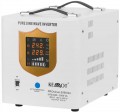Max. current
The maximum current drawn by the UPS. In fact, the current reaches its maximum value only when the UPS is operating from the mains with maximum load power and a completely discharged battery. However, when calculating the load on the power grid, this parameter should be taken into account.
Rated output power
The effective output power of the UPS is, in fact, the maximum active power of the load that can be connected to the device.
Active power is consumed directly for the operation of the device; it is expressed in watts. In addition to it, most AC devices also consume reactive power, which is "wasted" (relatively speaking) is spent by coils and capacitors. Apparent power (denoted in volt-amperes) is precisely the sum of active and reactive power; it is this characteristic that should be used in accurate electrical calculations. See "Maximum output power" for details; here we note that when selecting a UPS for a relatively simple application, it is quite possible to use only effective power. This is at least easier than converting the watts claimed in the characteristics of the connected devices into full power volt-amps.
The most modest modern "uninterruptibles" give out
less than 500 watts.
501 – 1000 W can be considered an average value,
1.1 – 2 kW is above average, and in the most powerful models this figure
exceeds 2 kW and can reach very impressive values (up to 1000 kW or more in some industrial class UPS).
Battery(ies) connection to UPS
Rated voltage of external batteries that can be used in the UPS.
For more information about such batteries, see "
External battery connection", here it is worth saying that the voltage of the external battery must correspond to the voltage for which the UPS is designed. If these parameters differ, at best, the UPS simply will not start, and at worst, overloads and even a fire are possible.
In general, the more powerful the UPS, the higher the voltage of the external batteries it is designed for. However, there is no strict rule. Some models even allow for multiple voltage options, such as 96/108/120 V. It is also worth noting that a power source with the required voltage can be assembled from several lower voltage batteries connected in series: for example, 3 batteries of 12 V can be used to achieve 36 V.
It is important to emphasize that the standard voltages for most modern UPS systems are multiples of 12 V. However, car batteries cannot be used in these devices. Despite having identical voltages, car batteries are designed for a fundamentally different mode of operation. Using them in a UPS can result in, at best, improper functioning of the device, and at worst, fires and even explosions.
Max. charging current
The maximum current in Amperes that charges the UPS battery or battery pack. Frequent charging cycles with high currents reduce the battery's service life. However, charging in this mode will come in handy during regular power outages - it makes sense to use
high charging currents when you need to charge the batteries as quickly as possible while the power is on and be fully prepared for the next power outage.

